Cycling shells, vests, and gloves: How to stay comfy in ‘shoulder season’ weather
This article originally appeared on Velo News
The eastern sky has a faint hint of light as I pedal down my row of brownstones in Brooklyn, heading out on a ride. It's 48F (11C) degrees, but by midday, it will be 70F, partly sunny with a 50 percent chance of rain. I plan to be 50 miles from my Brooklyn home, riding a shaded rolling road by a river that ends in a climb. I plan to wear a thin, thermal jersey, a windproof vest, long finger gloves, and knit shoe covers. Temperate weather will not favor us until late May. Until then, we waffle in "shoulder season," with widely variable weather conditions. I've done a thousand of these rides, first as a commuter, and later as a roadie. This is the cycling apparel I've found that works best. Also included are a few tricks to using what you have to work on a budget.
Also read: Epic Ride Weather review: One of the handiest cycling apps just got better
A general guide to dressing for success during spring and fall rides: check the hourly weather forecast the morning of the ride, and be sure to check the weather at your destination/halfway point if it's a long ride; bring packable outerwear; wind-proofing can do a lot; use layers and loft to stay warm including for hands and feet, and if you're bold: use embrocation. I'm a fan of Mad Alchemy embro and if it's really cold, be prepared with hot packs for your extremities. The trick is to use as few layers as possible without being cold.
Outerwear materials and a decent base layer are key to staying warm but not sweaty, with relatively few layers. Whether the items are heavy or packable, and when buying online: the contents inform my expectations of the garment.
For instance, nylon is tough and usually wind-resistant, the amount of elastic determines the stretch and informs how small of a size I'd order if I want the garment fitted. The fill material and level of "packability" vary by the type of ride, but in general, a big temperature change means shedding (or putting on) layers, and for this purpose obviously, something packable is preferred. It’s best if a packable item doesn't fill a pocket when properly rolled, but there are often spring days where it's windy and cold all day, in which case a more substantial shell is warranted. Whatever the item is, if it doesn't have its own pocket, I keep it rolled with a hair elastic or a bangle. I'm looking for thin but windproof items with double zippers so I can easily vent heat, and access pockets on layers underneath.
With the aim of keeping clothing bulk and layers to a minimum: An appropriately layered shell will work if it's not going to warm up much; a packable puffy is best if it's really cold at the start, or I'll be stopped any significant amount of time, or if it's more of a coffee ride. They're basically just regular jackets and as such are more useful than the typical skin-tight affair. Or I'll choose a packable vest if it's on the warmer end of the spectrum. These are my favorite baselayers, shells, "puffies," and packables - men's versions of the women's items are sometimes available. For legs, I recommend any tights you can find to fit over bibs, with a high waist so they don't slip. I have also stopped and bought stockings from Walgreens, in an emergency.
Base layer
Base layers should be comfortable, wicking, and not create unsightly lines under your tighter top layers. I used to think they were a waste of money, but a good base layer keeps skin dry and warm. If these are too extravagant, I've had good luck with this 32Degrees shirt (yep, the men's version), and a lot of people swear by Uniqlo.
Eliel Cambria Short Sleeve Base Layer ($80)
It's billed as a Merino blend but marked poly/elastane, but frankly, either way, it works. It wicks, and it's short enough not to leave a line around your hips like you had an allergic reaction to a hula-hoop. The only con: The sleeves are borderline "cap-sleeve," so make sure the jersey sleeves over top aren't super tight because that may create a line.
Velocio Merino Mesh Base Layer ($99)
Warm, wicking, and properly cut at the waist. It also doesn't have the itchy wool feel typical of some wool base layers. It does, however, look like long underwear -- but that's what it is.
Shell
A windproof outer layer that is less likely to come off for the duration of the ride. If the sun is never going to come out, or that forecast 20-degree temperature change never really gets you "warm," then a windproof, water-resistant jacket or vest with a double zipper over a jersey is the perfect outer layer. Adding base layers -- thermal or not as needed by temperature -- is the way to go.
If you’re caught out on the road in the wind and/or rain with no shell what to do? Desperate times call for desperate measures: A plastic bag underneath (or over) clothing is better than nothing.
Ostroy vest: ($130)
I've mentioned them before, but this vest bears repeating. It’s not technically a "shell" in that it has no arms, it's heavier than the average vest, yet not insulated. The WinTex low-stretch poly-blend is heavier than your typical packable item, not as bulky as a packable puffy, but it will take up a whole jersey pocket. Where the packable puffies are so warm, I plan to take them off at some point during the ride, the Ostroy vest is a permanent affair. It's "roadie" gear, and I don't anticipate having a ton of on-bike storage while doing roadie things, therefore I wouldn't want this vest to take up valuable pocket space, especially since it has its own three pockets. I needn't even open it unless absolutely necessary. This isn't as hot as a puffy; I can make good use of the double zipper to stay cool but keep the vest on.
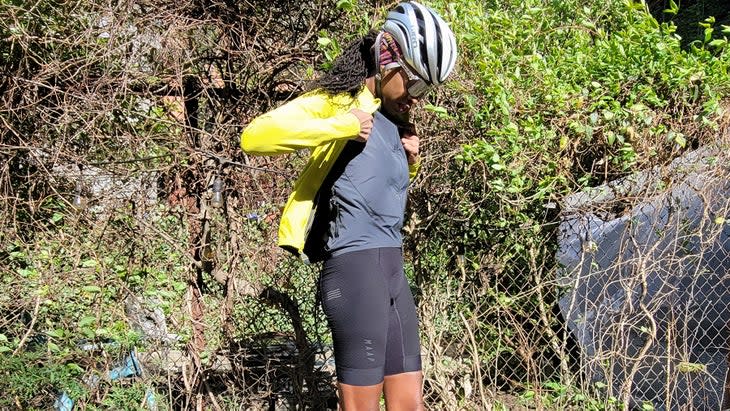
Ornot Magic Shell: ($228)
How does something that feels so heavy in the hand, feel so light on the body? The Polartec Neoshell is like Gore-Tex, but more breathable and slicker to the touch. It is truly magical. A double-zipper allows for easy venting, and the right side zipper pocket is big enough for late model flagship mobile phones with a thick case. It even has enough stretch not to fit like a potato sack. You could roll it down enough to fit a jersey pocket if necessary, to about the size of a water bottle. I wore this to Rasputitsa, in Vermont, in April.
Packable Jacket
This is the gear to grab if you need a jacket for every day as much as for cycling. A puffy jacket works for race mornings, mountain climbs, camping, and any ride with a vast temperature change that's not going to be too wet, or during which you expect to do some standing around. It also works equally well at the grocery store. Since I understand everyone doesn't have a big budget, the inexpensive version of the following options might be a Uniqlo packable puffy, but obviously, it won't have the same convenient (and at times, necessary) features or fit of a cycling-specific jacket. The issue with packable puffies, in general, is they're not easily packable. Good ones pack into their own pockets, but even packed-away they're unlikely to fit in a jersey pocket. But I think they are still worth the investment for the aforementioned scenarios, or if you find yourself in need of a general-use light jacket.
If you didn't bring a packable and you're freezing? Check at a gas station, drug store, supermarket, Target, or Walmart for an emergency blanket (if you're at a Target or Walmart and have the cash, just buy clothes). If you cannot or do not want to buy clothes or can't find an emergency blanket - stop at a gas station and insulate yourself with newspaper or paper towels. If you’ve gone full-backwoods with no gas stations for miles: Use grass or leaves if you're going hypothermic, but be careful which ones and don't put them next to your skin. The idea is to create a "loft" to trap warm air as well as help block the wind.

Universal Colours Unisex Insulated Packable Jacket ($230)
A well-made, slim-fitting hooded packable jacket with a double zipper, two zippered side pockets, and an internal valuables pocket that looks like a normal light winter jacket. When packed into the valuables pocket, it was a little bit too big of a square to fit into a normal jersey pocket. It would fit into one of those kangaroo pouch jerseys with one massive pocket that goes across the whole lower back, as long as it can fit past the zipper. Despite the bulk, its 80 grams per square meter translates to a very light coat (typical weights for lightweight jackets are 100-200). UC has wonderfully long sleeves to accommodate a riding position, a lower rear hem, and even a glow-in-the-dark rear hem flap with reflective lettering. It's held up out of view on the inside of the jacket with magnets; fold it down when needed for added visibility. In keeping with UC's sustainability promises, the main fabric is 100 percent recycled nylon ripstop.
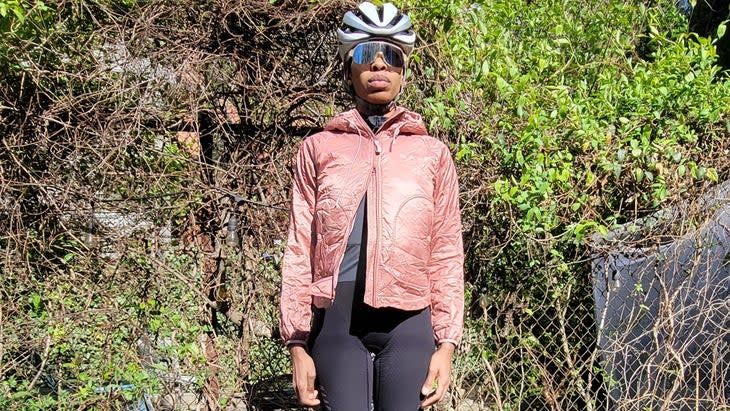
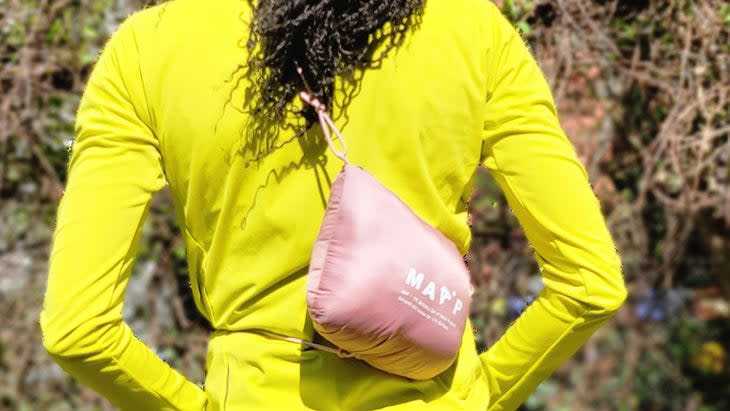
The Arrivals MAAP Alt_Road Haelo Women's Packable Jacket ($320)
An adjustable drawstring hood with a separate collar and zip vents at each hip made this jacket a bit more substantial and flexible in fit than the UC. The Primaloft Black Eco thermal insulation is also warmer (Primaloft is hard to beat). But the stellar feature was the elastic sling on the packable pocket that lets you carry the jacket once it's stuffed away. A huge deal when actually taking these things on a ride since storage is at a premium, thank you MAAP. UC has better sleeve and body length, however, whereas this made me wonder if it’s aimed at people who ride a bike with no bar-to-seat drop. This is definitely warmer, however, with the Primaloft material storing heat like an oven.
Packable vests and windbreakers
For when it's cold, but not that cold. I throw on a lightweight thermal jersey underneath so that midday I can shed the thin packable and avoid looking like I just left the sauna. These are the best of the best, but I also have a plain dyed-black packable vest from AliExpress that was $20 and has a double zipper. It's not nearly as packable or warm as the UC lightweight or insulated vests (it's a heavier polyester but not insulated,) nor as beautiful, and the zipper pull isn't sized correctly so it gets stuck. I have no idea about the ethics of the factory where it was produced, but budgets vary and I will not begrudge the sharing of information.
Universal Colours Chroma Insulated Unisex Gilet: ($200)
The loft of its superlight Comfortemp filling makes all the difference - the warmth-to-weight ratio is fantastic, and the outer fabric has an environmentally safe coating against light rain. The reflective emblem on the back, though large, is just subtle enough and adds visibility before dawn and after dusk. It has a double zipper with a nice long fabric pull for venting. The Insulated Gilet is not as thin as UC's beautiful iridescent vests, but still fits into a pocket with room to spare; it's also not as visually arresting, which makes it a versatile mix and match item for building a cycling wardrobe. It has three rear pockets, and a zipper pocket, so I can wear it with just a long sleeve base layer and bibs and still be able to carry things. Smooth fabric with a seam-sealed, silicone-lined bottom hem that's lower in the back and makes a perfect fit. There is no cheap version of this; other insulated vests look chunky by comparison. It's expensive, but this might be my favorite piece of kit this season.
Universal Colours Spectrum Lightweight Unisex Gilet: ($135)
This is the earth-toned colorway I didn't know I needed. It has a small zipper pocket on the back suitable for keys, cash, and a small snack that's also designed to stuff the vest into. Since it's oblong, it doesn't even take up a whole jersey pocket once stuffed away. I wish it had a double zipper, but I've settled for a long fabric pull: It's VERY rare for me to like a vest without a double zipper. I've only broken my rule for two companies: Ostroy - with the older version of their Floral vest, and Universal Colours, with this gorgeous and smart fabric choice.
Eliel Gibraltar Jacket ($180)
Well-made standard race-cut water-resistant windbreaker with a double zipper; that simple feature is often overlooked. A good windbreaker gets a lot of use because of its versatility: Put it over a heavier thermal jersey with a base layer, and it's good in winter. Use it over a short sleeve jersey for windy rides or long cold descents in spring and summer.
Gloves systems, shoe covers, and hot-packs
It's not just one glove, but many. Again, the trick to warm hands and feet is creating loft - space for the warm air to accumulate. Full disclosure: I've gone through pogies, lobster-claw mittens, and heavy gloves for my hands; toe covers, oversocks, neoprene booties, and finally boots for my poor toes. But a system of layering gloves and oversocks works for me. The only thing I haven't tried is heated gloves, but I won't hesitate to stop at a store for a hot pack. Assos, Hirzl, and Dissent all offer glove systems, but the important takeaway is: use a liner and a wind-blocking shell and insulate as necessary. If you get stuck out there with cold hands, a pair of hot packs and gardening gloves large enough to tuck the hot pack into can work wonders. Similarly, sock mittens if you're desperate.
The trick to getting the most out of knitted overshoes is to wear them over a wind-sealing layer and to tape closed any vents on road shoes. I have shamelessly put a plastic bag between a knitted shoe cover (that would allow air to pass through) and my shoe/leg. Just make sure it's a color that matches your kit since the bag may show through depending on the tightness of the knit. Also, if foot hot packs come into play, put them on the top of the shoe instead of the bottom, it will help keep your foot hotter as most people have thinner skin on the top of their foot than the bottom. If it's very cold, I'll use overshoe socks, then a neoprene bootie over that. If it's extremely cold, I'll just wear boots.
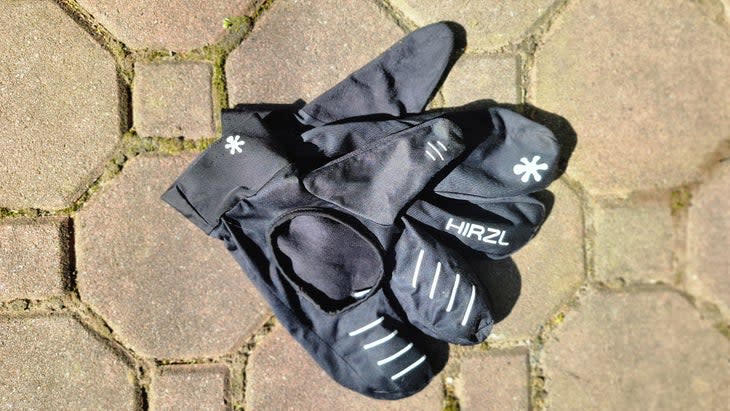
Hirzl Finger Jackets ($30)
Bringing these windproof, water-resistant over-gloves allows me to wear as thin a pair of long finger gloves as possible. If it's really cold, I'll also bring Hot-Hands, an air-activated disposable hot pack that fits through the palm hole in the glove and which I have worn jammed against the top of my fingers - you can sometimes find these at local drug and grocery stores. There are also rechargeable hot packs that double as battery chargers, but they will not fit comfortably into a glove when worn.
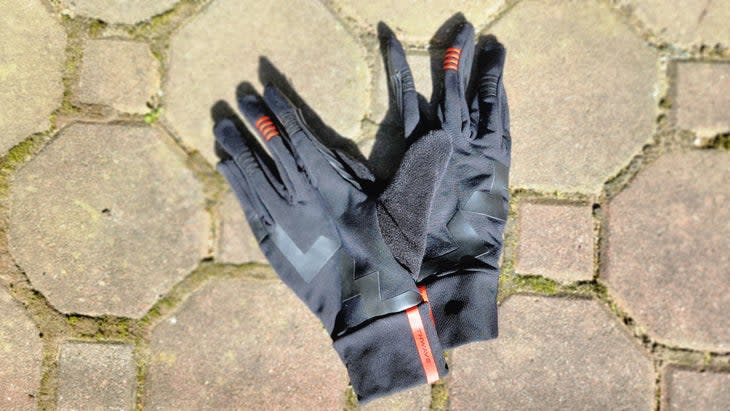
Northwave Active Contact Gloves ($35)
These are a fall through spring full-finger rather than a summer full-finger, meaning the material has some substance, is wind resistant to a point, has a terry-backed thumb, and pads and forefingers that work on my phone even though they're thick. Further, because the fingers are longer than the average glove, they haven't had the issue where they split at the fingertip seam, which has happened to almost every other glove I have.
Specialized Reflect Overshoe Socks ($35)
A reflective band at the calf gives the overshoe socks their name. They're slightly tougher than the usual pair of athletic socks and come with holes pre-cut and sealed. I use this as a top layer to hold in the aforementioned wind-stopping plastic layer, or to insulate under a heavier overshoe.
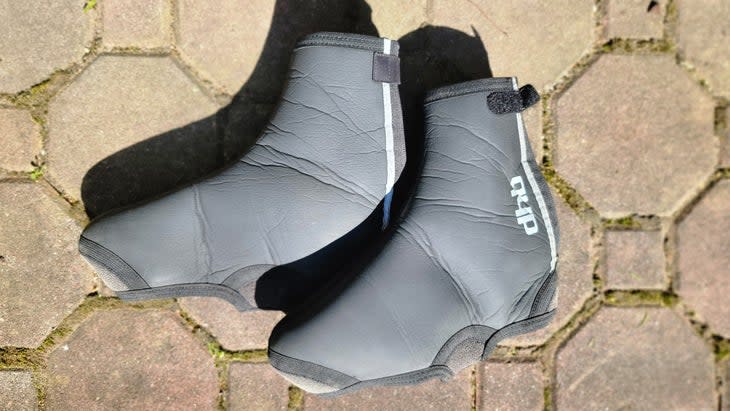
DHB Neoprene Nylon Overshoes ($45)
The reinforced heel, toe, and footbed have helped with longevity. I went through quite a few of these that were missing the reinforcement, which meant whenever I walked, it would pinch or grind the toe against the ground. They do a good job of blocking the wind and are well sewn so that I can zip them tightly against my foot.
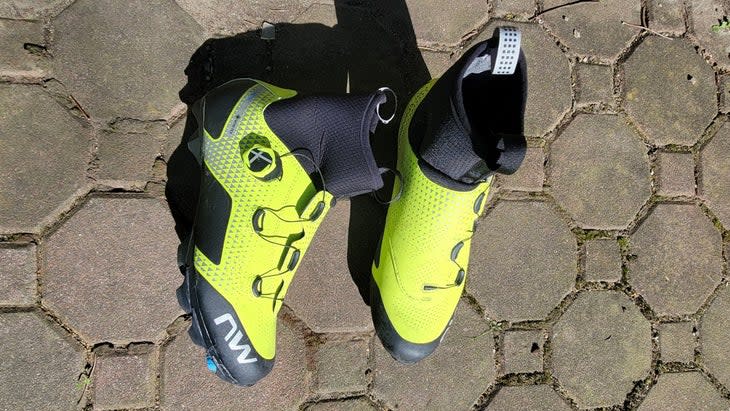
Northwave Celsius XC Arctic Boots ($279)
They're a two-bolt cleat system and an alternative to giving up entirely and putting on flat pedals and wearing hiking boots. The sole is stiff to transfer power (8.0 on the stiffness index), the natural rubber outsole prevents slipping, and the interior footbed is cushy enough to feel OK when walking. They are waterproof, and insulated with 4 layers (EVA, aluminum, EVA, pile), especially in the toe. The neoprene ankle collar has a Gore-Tex membrane. The ratchet system still makes no sense to me whatsoever, but the boot does the job of keeping my feet warm and dry. Both the black and my neon colorway have 360-degree reflectivity.
For exclusive access to all of our fitness, gear, adventure, and travel stories, plus discounts on trips, events, and gear, sign up for Outside+ today.

